Sluice boxes are simple, inexpensive (mostly) equipment used to find and recover placer gold from streams and rivers. For hundreds of years, a basic sluice box design has been effectively used, with a significant amount of gold sourced during the early gold rushes being found in them.
Since the days of old, modern designs have been implemented with success.
These sluice boxes are a blast to operate and make finding gold easier than scooping pay dirt into a gold pan and then having to pan 1 to 2 scoops at a time. They can be a little tricky to set up correctly but there are plenty of YouTube videos explaining how to get the angle and water flow correct.
Types of Sluice Boxes
There are various sluice boxes on the market these days; regardless of the make or model, they’ll all find gold. Let’s talk about ‘em.
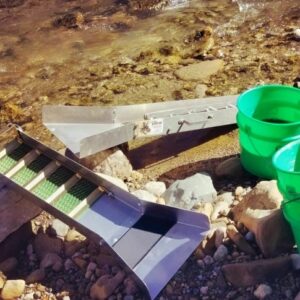
Keene Sluice Box
Keene Engineering has been making sluice boxes for 73 years or more. Since 1955, Keene has been one of the go-to companies for mining and prospecting equipment.
Keene produces hand sluices and power sluices, too. They sell combination kits with everything a prospector needs to hunt for gold. You’ll find various sizes, from the supermini sluice box to the larger models like the super and high production sluice boxes. Of course, they offer medium-sized power sluices, too.
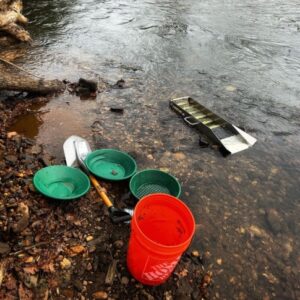
Gold Sluice Box
Gold Well Vortex Drop Riffle Sluices work by creating a gentle, vertically-oriented vortex, which keeps the materials in the spiral-shaped wells in motion. This causes light materials to flush out more easily while concentrating heavy materials. Whenever gold crosses the vortex, it doesn’t have a stable bed to rest on, so it drops to the bottom, where it stays.
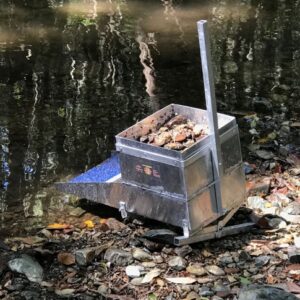
Highbanker Sluice Box
Power sluices of highbankers are gold prospecting equipment that utilizes a pump to force water through the sluice box, mimicking the natural flow of rivers. Some models have a hopper box with spray bars and grizzly screens (or classifier sieves). Gold-bearing gravel gets shoveled into the hopper, where it washes over the classifier screen to remove any waste gravel and chinks of rock too large to pass through the sluice box.
Highbanker sluice boxes can be gas or electric-powered. However, recirculating highbankers or recirculating power sluices are often powered by 12-volt electric batteries.
The benefit of this sluice box type is that you don’t have to haul materials to the water. The box can be carried straight to the source.
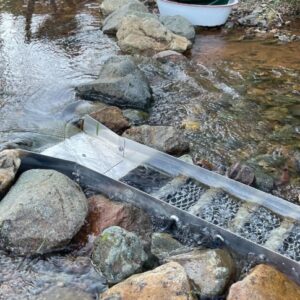
Stansport Sluice Box
Stansport Aluminum Sluice Boxes are excellent models that power through more considerable amounts of gold-containing materials in a short amount of time. Because the sluice is made with lightweight aluminum and has carry handles, it’s easy to transport from one location to another. Stansport sluice boxes also feature removable riffles. The addition of the expanded metal mesh simplifies capturing tiny gold flakes because it all adds up!
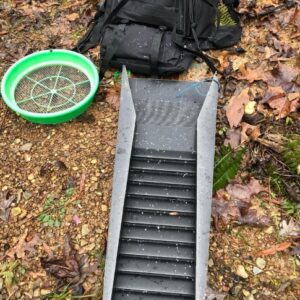
Bazooka Sluice Box
Bazooka boxes are well-known for their ability to recover a high percentage of gold from the paydirt. Unlike traditional sluice boxes, fluid bed sluices do not use riffles, carpets, or matting to capture the gold. Instead, a fluid bed of water, sand, and small pebbles is utilized in a collection tray to trap gold.
Bazookas are prized for their fine gold recovery, especially the longer sniper and any of the prospector or miner models.
However, the Grizzly Gold Trap seems to have replaced Bazooka. Once Bazookas stopped being made, Grizzly stepped in to keep prospectors prospecting.
How To Use A Sluice Box
Before you set up your sluice box, you’ll have to find the best location. A spot in the stream where water moves quickly enough to carry away gravel and dirt. However, it shouldn’t move so fast that it washes the gold away, too.
Setting A Sluice Box Up
An adequately set up sluice box is crucial if you intend to separate gold from the other materials efficiently.
- Once at the creek, stream, or river, locate an easily accessible shallow area where you can access the water safely and effectively. It would be a shame to haul your sluice box and equipment partway through an area only to discover that the honey pot isn’t accessible.
- A sluice box should be at a slope of about 5 to 7 degrees. This angle allows for an efficient separation of materials. A level is a handy tool to have on hand.
- Before you feed your sluice, classify the materials. Use a screen to remove large rocks and debris that can clog up a sluice box. Doing so can ensure the right-sized materials enter the box.
- It’s finally time to feed the sluice with material. Start out with a slow feed rate to allow the materials a chance to settle properly. With more experience, your feed rate can increase
Once you’re done sluicing, clean the sluice box to remove any accumulated materials. I suggest using a hand pan or classifier to sift through any remaining debris; there could be a bit of gold in there. Happy prospecting, and stay safe out there!
- Identify Enstatite - March 12, 2024
- Identify Cerussite - March 3, 2024
- Identify Bytownite - February 18, 2024
